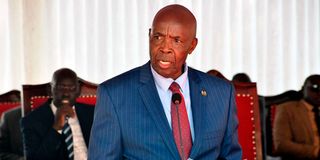Ranking of schools serves no purpose

The Cabinet Secretary for Education, Mr Ezekiel Machogu, did away with the ranking of schools or students when he released the 2022 KCPE and KCSE examinations results. The CS, however, provided facets of information on the performance of a few secondary schools a week later.
What you need to know:
- Ranking of schools or students has zero educational value. It did not serve any rational educational purpose.
- Educational policy, curricula and standards do not provide for the ranking of schools or students. It is not the objective of a school-level examination to rank students.
- On the contrary, examinations provide critical feedback on the quality of teaching and learning experiences students have had over a period of time.
The Cabinet Secretary for Education, Mr Ezekiel Machogu, did away with the ranking of schools or students when he released the 2022 KCPE and KCSE examinations results.
The CS, however, provided facets of information on the performance of a few secondary schools a week later.
He did it, not to sanctify ranking, but to dispel some misinformation to the effect that two counties accounted for 800 candidates out of 1146 who scored A grades.
Ranking of schools or students has zero educational value. It did not serve any rational educational purpose.
Educational policy, curricula and standards do not provide for the ranking of schools or students. It is not the objective of a school-level examination to rank students.
On the contrary, examinations provide critical feedback on the quality of teaching and learning experiences students have had over a period of time. It also evaluates the quality of the teaching and learning environment.
Policymakers use examinations to evaluate the depth and breadth of knowledge, skills, abilities, or values that students have acquired in the light of a prescribed curriculum.
Examination patterns
The patterns in examination results answer such questions: have the students mastered the knowledge, skills, attitudes and values the curriculum represents?
Can they apply the knowledge, skills, abilities, attitudes and values in situations the questions simulate? Has the curriculum experience they have been taken through made them better thinkers?
Can they apply the different bodies of knowledge to deal with problems, issues and challenges relevant to the various bodies of knowledge they acquired? Have the teachers interpreted and implemented the curriculum as prescribed?
In a press conference at the Kenya Institute Of Curriculum Development (KICD) recently, CS Machogu said the international benchmark for qualification into university is normally 30 per cent of KCSE candidature.
“The global benchmark for the C+ grade is actually 30 per cent. Kenya has not even reached 20 per cent. Therefore we have a lot to do to get more learners to achieve C+ and above,” the cs noted.
Implicit in this remark, was an equally critical purpose of an examination. It prepares students for higher education, training and work.
It is the reason why Machogu raised the question: “why is there a disproportionate number of students getting D grades and below?”
In principle, four years of secondary education should enable the majority of students to join tertiary institutions: to study for diploma certification.
A national examination provides an opportunity to improve teaching and provide additional help to schools.
Kennedy Buhere, Nairobi




